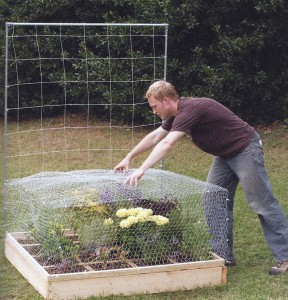Protective Measures against Pests & Diseases in the Square Foot Garden
By Sally Hansley Odum
No matter what type of garden you have, you will eventually run into the problem of what to do about pests. Worms and rabbits will try to eat up all your collards and tender greens. Squirrels, coyotes, foxes, birds, deer, and more all want a piece of your harvest. What is a gardener to do?
Square Foot Gardens are the easiest of all to protect. If you have a problem with squirrels, rabbits, or even dogs and cats getting into your beds, you can attach a “critter cage,” which is a wire cage that goes over the top of the garden bed. Make one using chicken wire, buy one ready-made, or cross two PVC pipes over the top and cover it.
Mel Bartholomew’s book, Square Foot Gardening Answer Book, addresses a lot of these issues. In it, you’ll find homemade remedies for practically every sort of disease or pest. He also gives a lot of pointers in his latest release, ALL NEW Square Foot Gardening, revised edition.
A few tips for prevention of disease and pests:
- Water at the ground level to prevent fungal diseases like powdery mildew. It thrives in moist, dark, overcrowded conditions. Misting from overhead encourages its spread. Once the disease appears, rid the garden of those plants and don’t put them in your compost pile. Fungal diseases spread easily.
- Organic insecticides work against worms, unfriendly beetles and bugs.
- Keep your plants healthy and well-nourished. Diseased plants attract harmful bugs to your garden.
- By the same token, remove all rotting fruit as it draws insects and animals alike.
- Place your compost pile away from the garden beds. Rotting vegetables and fruit may attract animals and pests to rummage for food.
- Hand-pick as many insects as possible and dispose of them. Look on the undersides of leaves for eggs or worms. If you have a large infestation, only then resort to soapy sprays or organic insecticides.
- Introduce ladybugs into your garden. They are a beneficial insect.
- If you can keep chickens and ducks out of your beds with a critter cage, then allowing them to free-range near the garden is a bonus because they consume a lot of bugs and worms.
- Plant flowers to attract beneficial pollinators to your garden.
- Look into companion planting. This is a system whereby you plant one thing that helps another to thrive and grow, or deters pests.
- Chrysanthemums are said to deter pests. A spray made from them can even keep away bed bugs and fleas. Other plants that deter pests are Borage, Chives, Catnip, Basil and Artemisia.
- To deter moles, voles and gophers, Mel Bartholomew advises, “When you first build your boxes, staple or tack down something called hardware cloth that is available in every hardware store.”
- Don’t forget to also protect your pets FROM your garden plants. Tomato leaves, grapes, garlic, onion, and chives can be toxic to pets.
Every garden should be a harmonious marriage of nature with a blend of beneficial bacteria and insects that hopefully will outweigh the detrimental pests. When that balance is disrupted, usually just a little oversight on your part will prevent the problem from escalating and restore harmony!




